A guitarist’s pedalboard layout and signal chain says a lot about them. Do they prefer a small board with just the essentials, or go for a massive one capable of producing any sound known to man?
To complement our Pedal Board Buying Guide at zZounds, we thought to ask zZounds staffers to share pictures of their own pedalboards. Read on, and share your own signal flow philosophy in the comments below!
Shop the Pedal Board Buying Guide >>
Matt’s Board
Those of you who follow the zZounds blog may have seen my Ultimate Pedalboard Build Guide last year, where I walked you through my last pedalboard build. For those who didn’t, here’s a picture of my last board:
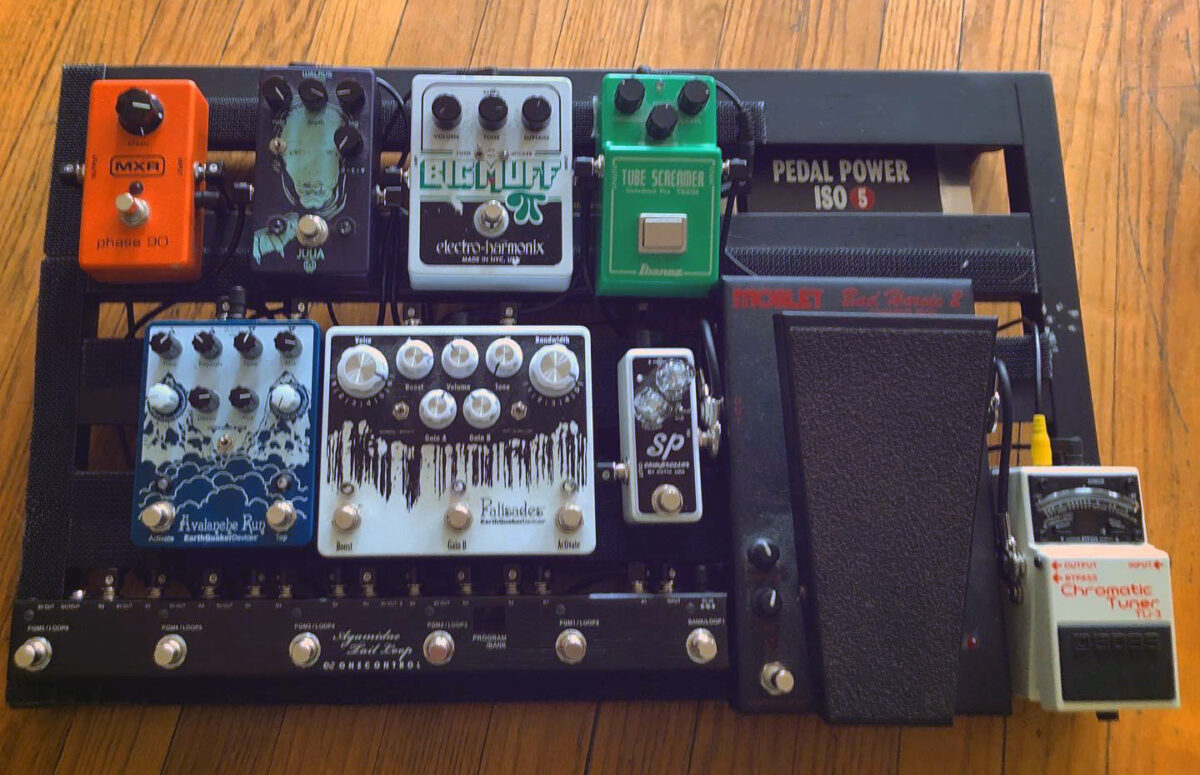
Recently, I decided to swap out the Avalanche Run for a Carbon Copy Deluxe. I love the degradation of the delay trails and the tone of the classic analog delay. I didn’t want to loose the tap tempo functionality, so I went with the Deluxe over the original Carbon Copy. It’s also nice to have controls for the modulation and a switchable bright mode, to help cut through the mix a little better.

The rest of my board has remained the same. Boss Tuner>Morley Bad Horsie 2>Xotic Sp Compressor>Ibanez Tube Screamer>EarthQuaker Palisades>EHX Big Muff Pi w/ Tone Wicker>Walrus Audio Julia>MXR Phase 90>MXR Carbon Copy Deluxe, all controlled with a One Control Loop Switcher. I’m really happy with the order and combinations available to me.
I’ve been gravitating toward simpler pedals and a more simplistic setup. I find it easier to dial in the right sound and find the right pedal for each type of effect. I’m planning to downsize to a Pedaltrain Metro 24 board in the near future and have a board that’s a little more portable with fewer pedals.
-Matt, zZounds Customer Service Representative
Pat W’s Board
First and foremost, the heart and soul of my rig is running a ’65 Reissue Fender Princeton Reverb and Mojotone clone of a Fender Tweed Deluxe in dual mono. Yes, I run two amps at once because I am a mad man, and I think it sounds a lot better.
Anyway, my chain (set on a Pedaltrain Classic JR) goes as follows: TC Electronics PolyTune2 Noir, J. Rockett Archer, J. Rockett The Dude, Dunlop Fuzz Face Band of Gypsys, Way Huge Aqua Puss Smalls, Walrus Audio Monument, and a Radial Twin City. I tend to push my amps on the edge of breakup because I feel like the best overdrive tones come from the amps themselves. The number one thing I need in a pedal is it being responsive to the guitar’s volume control and how hard I pick. I never have more than two pedals on at once because the amps are usually screaming.
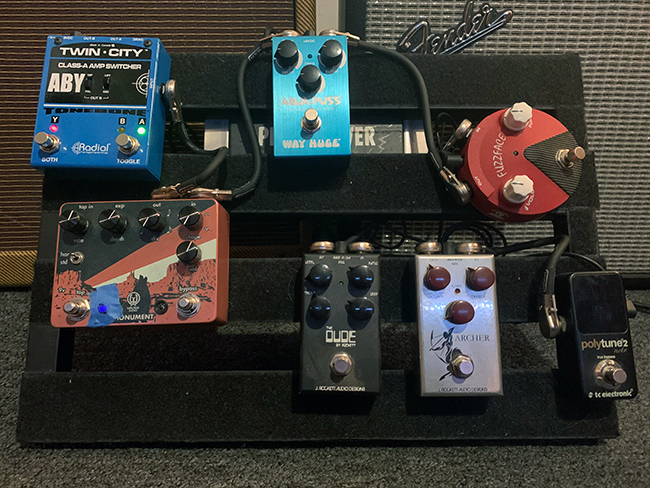
I use the TC Electronics PolyTune2 Noir because the display is big and it’s easy to see in daylight. The J. Rockett Archer is my favorite overdrive pedal that I’ve found because of how responsive it is. I’m not a huge “amp in a box” kind of guy, but the J. Rockett The Dude emulates that Dumble sonic territory. From a very early age, I have loved Jimi Hendrix’s fuzz tone, so when Dunlop issued the Band of Gypsys Fuzz Face, I was sold. The only pedal that I have on all the time is the Aqua Puss for a quick and subtle slap back. Because I love all things Fender, the Monument a harmonic tremolo similar to what you find in brownface Fender amps from the early 1960s. All the way at the end of the chain is the Radial Twin City that allows me to split the signal into my two amps.
-Pat, zZounds Guitar Merchandiser
Jimmy’s Board
The physical board itself is a Pedal Train Classic 2 with soft case. My pedal board serves a very specific purpose and it sure doesn’t look pretty but it gets the job done. I have never been a fan of “pedal platform” amps. My pedals all add their own flavor to the only amp you will ever need: A Marshall JCM 800. I use my pedals as an augmentation to my amp’s natural tone as opposed to replacing my entire tone with one single pedal.
My signal chain starts at my Ernie Ball VP Jr. and from there it enters my older-than-time Boss TU-2 tuner pedal. I really like having the volume pedal at the start of my chain because I use it as a way to get from a crunchy clean tone to a full distorted tone. I use the tuner as a mute pedal as well. From the tuner pedal, the chain continues into the Loud/Louder. This basically allows you to add gain on the front end of the amp, which is nice if you already have a crunchy tone or you are trying to create a boost for your clean tone. In all honesty, the only pedal you really need on this board is the Loud/Louder. It makes the amp naturally breakup and that’s my favorite tone.
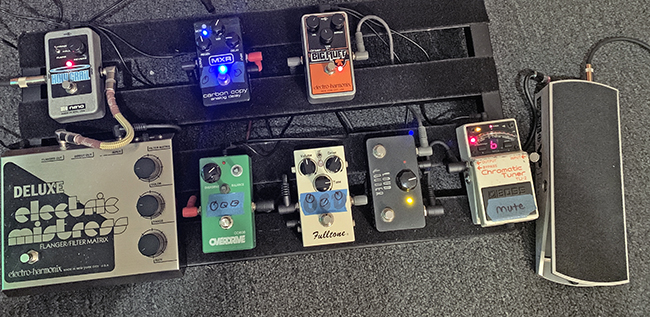
From there we move into 3 different gain stages. The Fulltone OCD is set to let me add more low saturation to the guitar tone and boosts the mids a bit. This is used for any leads and is never used on its own. The signal then continues into the Maxon OD808. I use this with both the Loud/Louder or on its own. I love how transparent the overdrive of this pedal is. The signal chain then continues into the EHX Big Muff Op–Amp. This is dialed in with very light settings to “fuzz” up the signal a bit. I use this for leads, chunky chords, or palm muting.
We then move onto the MXR Carbon Copy, which I use for a shorter, almost slap-back, delay when I need it for leads. Next is the EHX Deluxe Electric Mistress. I use this to just add a bit of body and color on cleaner tones. We finally reach the EHX Holy Grail which remains on the spring setting at all times. It is set almost in the off position, but it’s enough to give a little reverb to my signal. The signal leaves the pedal board and enters the low impedance input of my 1983 Marshall JCM 800 2204.
-Jimmy, zZounds DJ Lighting Merchandiser
Nick’s Board
As much as I fancy myself an eclectic listener and creator when it comes to music, my pedalboard — a Music Nomad M128 board –always seems to be built around my ideal “shoegaze” tones. For years I played in bands and projects that utilized a ton of reverb and endless delays. My current board features some of those “shoegaze” tone artifacts but I’ve attempted to bring it up to speed with my current playstyle and tastes.
I start my chain with a ’95 Fender Telecaster equipped with Vintage ’52 pickups (reissue) then it moves into a Boss TU-3 tuner, a full-sized Ernie Ball volume pedal. (thanks to my size 12 feet) After that we get into the interesting stuff, starting with my reverb, the One Control Prussian Blue reverb. Before the comments start, I’m personally a huge proponent of verb before dirt. I feel that there’s nothing better than the amazingly cloudy tone of an overdriven or fuzzed out wall of reverberated guitar tone. This is the first artifact from my shoegaze days, as you truly cannot get (in my humble opinion) a better “wall of sound” than with reverb before dirt.
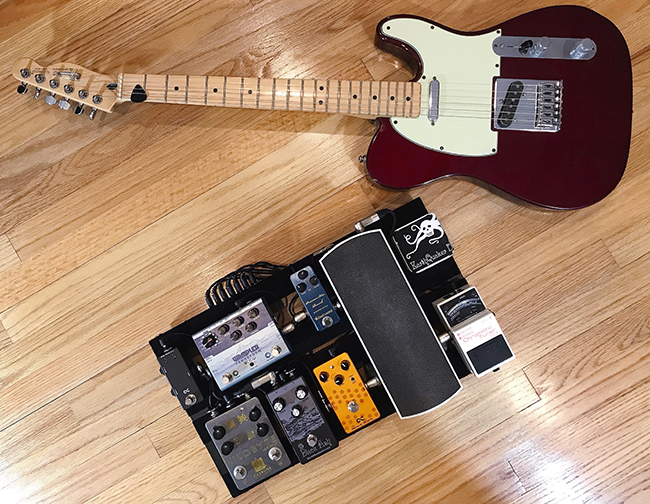
Alright, moving on! One of my favorite pedals that I’ve recently acquired, the One Control Honey Bee overdrive is next in line. It’s warm but transparent and “boost-like” when it needs to be. It can get very crunchy when I’m feeling that tube style OD sound as well. There’s a switchable “vintage” and “Modern” setting, which is great for adding or subtracting some darkness in your tone. I usually keep mine on “vintage” as I’m a big fan of the early Marshall tube amp sound; this pedal does a great job of keeping that tone alive.
After that, we’ve reached the crown jewel of my fuzz collection: the EarthQuaker Devices Black Ash Endangered fuzz. I was lucky enough to snag one of these from their limited “1500 units worldwide” launch a year or so back. It’s built using Jamie Stillman’s personal stash of rare and irreplaceable components like: paper-in-oil capacitors and NOS half-watt carbon composition resistors. It sounds so big and I’m incredibly fortunate to have the opportunity to play such a divine piece of fuzz history.
After that, we’ve got another newer addition to my board, the Wampler Terraform multi-modulation pedal. Modulation is such a key piece of any tone puzzle for me. This pedal is incredibly potent and you can truly get lost in it if you’re not careful, but I usually write my parts without modulation in mind and then add it in during a rehearsal or co-op writing session. I feel that when you introduce modulation into a “band” setting it shows very quickly if it “hits” or “misses” in a specific composition. It’s kind of like a “sink or swim” mechanic I’ve built into my writing workflow. The Terraform is such an amazing tool for writing and live production with its tactile workflow and ability to save presets. I will not be taking this off my board anytime soon!
Next in line is my delay, the Caroline Guitar Company Kilobyte Lo-Fi delay. This pedal consistently beats out any other delays I introduce into my rig. It offers a realistic analog voicing while keeping the accuracy of a digital design. Plus the “Havoc” switch that lets your delay repeat indefinitely until you lift your foot is tons of fun. All this is why the Kilobyte has served the longest stint on my pedalboard.
And finally we end our board chain at the One Control Minimal Series AB box. This is a switchable dual output pedal that lets me utilize a stereo rig if I’d like to. Highly utilitarian, but necessary if I want to push double the air.
All of this is fed into my Marshall JTM 45 and hopefully I’m playing in a club cool enough to let me dime it.
Fender ’95 MiM Telecaster > Boss TU-3 > Ernie Ball VP > One Control Prussian Blue reverb > One Control Honey Bee overdrive > EarthQuaker Devices Black Ash Fuzz > Wampler Terraform multi-modulation > Caroline Guitar Company Kilobyte > One Control AB > Marshall JTM 45
-Nick, zZounds Pedal & Bass Merchandiser
Sergio’s Board
Despite the mix of new and old pedals, the setup for this board has stayed relatively consistent for at least a decade. First, I plug my guitar directly into the Boss TU-3 tuner. I do this not only to keep my signal as clean as possible for the tuner, but because all Boss pedals have a built-in buffer. Having this buffer first in my signal ensures that the tone is preserved over long cable runs and through the circuitry of my other effects. Next, the signal goes through the Ernie Ball Volume Pedal, which I use to control the gain of my amp.
After the volume pedal comes the modulation section of my board. First, through a vintage Electro-Harmonix Small Stone phaser, then through a Boss BF-2 Flanger. I’ve owned three Small Stones, and this is by far the sweetest one yet. I like to use it with the rate relatively slow for subtle, creamy sweeps. I set the Flanger depending on the song, or whatever I’m playing. Slow flange sweeps work really well with the Small Stone to create what sounds like a lot of detailed movement in the signal, or I can use the BF-2 by itself with the rate turned up high to simulate a Leslie effect.
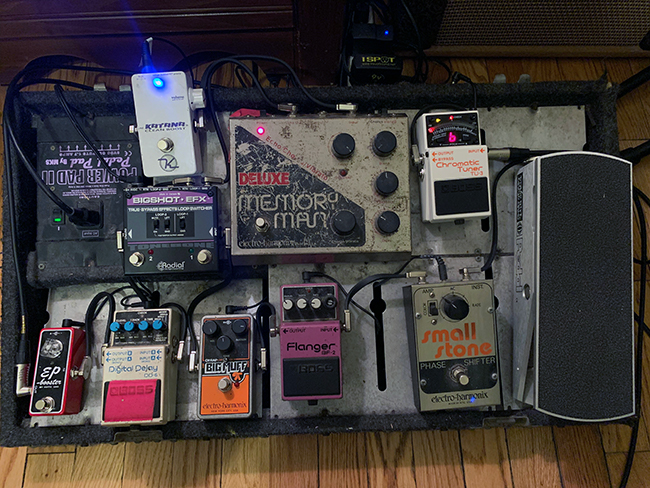
Next up is my delay section. I have two delays that have been on my board for the better part of 20 years: an Electro-Harmonix Memory Man, and a Boss DD-6 Digital Delay. The Memory Man is old and noisy, but I love the textures it creates, and it has become such a big part of what I consider my sound, that I have a hard time giving it up. I’ve wired the Memory Man into its own loop with a Keeley Katana Boost using a Radial Big Shot EFX effects loop. The amplifier in the Memory Man is really noisy if I try to set it at unity gain, so I turn the output of the pedal all the way down, and use the Katana to boost it back up to unity. These two pedals are always on, and then the effect is engaged by the looper. While the Memory Man and DD-6 are both delays, I use them for different functions. The Memory Man adds depth and movement to augment the tone of strumming patterns and open chords, while I use the digital delay more traditionally for rhythmic pulses that I can set with a tap tempo.
Finally, the last pedal in my chain is an Xotic EP Booster. My main amp is a Marshall JCM 800, and it absolutely loves clean boosts slamming its input stage. The EP Booster does that with tons of push left to give, and also adds a sweetened top-end shimmer to my sound as well. This is a good pedal to always have on, then adjust the gain using the volume pedal or the volume knobs on my guitar.
Also pictured on the board is an Electro-Harmonix Op Amp Big Muff. This pedal really shines in front of a clean amp, adding some gnarly texture and ripping velcro sounds. Not pictured is a Wren & Cuff Tall Font Russian fuzz. The Tall Font has more of a compressed, tighter gain, with a healthy bottom end. Depending on my mood or whatever I’m playing, I typically keep the fuzzes on a rotation.
-Sergio, zZounds Guitar Merchandiser
Pat B’s Board
I’m using a custom-built patch bay to route my pedals through the effects loop on my Marshall Studio Classic Combo. I purchased the Marshall recently and before then I had never owned an amp with an effects loop. I absolutely love the way my amp sounds with a little bit of gain, but I also have plenty of modulation and time-based effects that do not sound good running into the front end. In order to make patching into the loop more convenient, I have my pedals routed through two separate loops on the board.
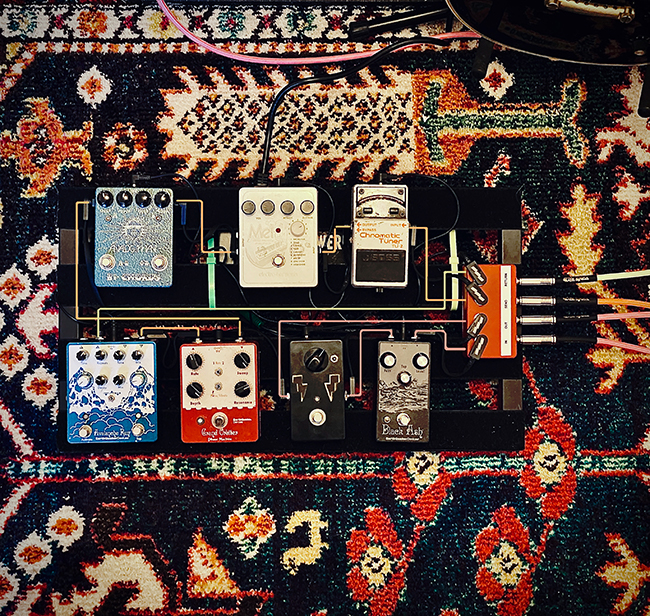
In the first loop, my signal chain is GUITAR > EARTHQUAKER DEVICES BLACK ASH FUZZ > JEXT TELEZ RANGE LORD > AMP
The second loop is my effects loop, which goes FX SEND > BOSS TU-2 > ELECTRO-HARMONIX MEL 9 > ANALOGMAN BI-CHORUS > EARTHQUAKER DEVICES GRAND ORBITER > EARTHQUAKER DEVICES AVALANCHE RUN
As you can tell, I’m a pretty big EarthQuaker Devices fan. I think they make great pedals for the price, and they all play well with other effects. One of my favorite sounds is running the Mel9 into a fast-speed chorus setting, feeding into the Grand Orbiter. This creates a really cool filtered organ sound that is useful for ear-candy and massive sounding chords. For my drive sounds, I use the Jext Telez Range Lord, which is a germanium Rangemaster-style treble booster, for 90% of my distorted sounds. When I need an extra bit of gain I will stack the EQD Black Ash into it, set to lower gain. On occasion I’ll use the Black Ash by itself and then boost it with the Range Lord for lead sounds, but usually I use booster as the main source of my dirt. You may ask why I’m running a Boss tuner in my effects loop – the answer is that the buffer in the tuner (which many people dislike) actually helps keep my other true-bypass pedals silent when I turn them on an off. By putting them in-between the buffer in the TU-2 and the buffered mode in the Avalanche run, I was able to eliminate annoying “pop” sounds. I’m not sure why this works, but it does!
The whole thing is routed through a custom-built 4 input/4 output patch bay, to keep things organized. On thing I love about this setup is that if I need to switch to an amp without an effects loop, I just connect the “OUT” jack to the “SEND” jack with a patch cable, and it works just like a normal pedalboard. In order to keep everything organized, I’m using neon colored Ernie Ball braided cables so I can keep track of what each cable is connected to.
John’s Board
Ok, so let’s talk about my absurdly large pedalboard. I know I know, tone is in the fingers, but hey…pedals are fun, so why not have a bunch of them? Don’t get me wrong, I love to “plug straight in” and attempt to rip the best dad-core solo I can summon up, but I also love to run through 16 little boxes that transform my guitar into something otherworldly, unique, and just plain sonically pleasing to my ears.
Since my OCD (no pedal pun intended) is borderline debilitating, I have all the cables running under the board, so here’s the signal chain. TC Electronic Bonafide Buffer > Boss FV50L Volume Pedal > MXR Dyna Comp Mini > J. Rocket Archer (painted black) > Fulltone OCD > Death by Audio Fuzz War > EarthQuaker Devices Data Corrupter > Z. Vex Lo-fi Junky > Old Blood Noise Endeavors Reflector > MXR M168 Stereo Flanger > DOD Rubberneck Delay > Walrus Audio Slo > Walrus Audio Fathom > Electro-Harmonix Superego > Boss RV-5. All of these lives on a Temple Boards Trio 28 and powered with a Walrus Audio Phoenix power supply.
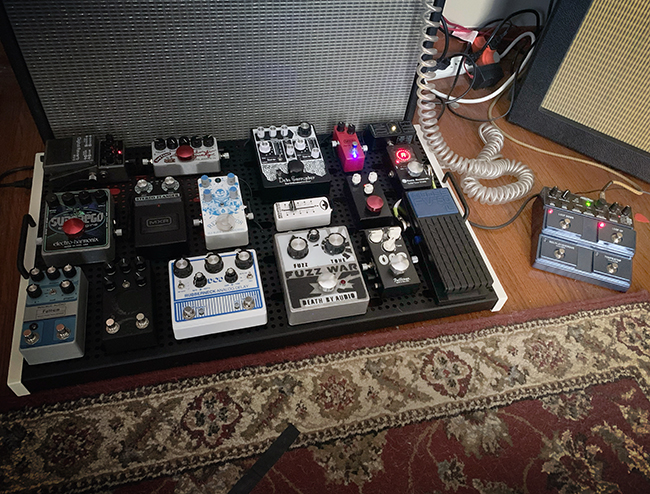
Ok, that was a lot (or maybe not?), but now you know the “what,” so I’ll attempt to explain the “why.” Forewarning, I’m not an electrical engineer, so bear with me as I explain things in layman’s terms. With this many pedals, it’s almost essential to have a buffer. Sometimes you’ll see buffers built-in to tuners, but in my case, I need a stand-alone unit to start the chain. If you’re ever wondering why you’re losing signal strength, grab a buffer. From there, I go to the volume pedal which I almost exclusively use for volume swells, because who doesn’t like a lush, ambient volume swell?
From there, I go into my “always-on” pedals. The Dyna Comp is first and used to control output and tighten everything up. I go back and forth with compressors, but for now, it has a home on the board. Next in line after that is the Archer. I run through clean amps with tons of headroom, so this adds a little grit to my “clean” tone and helps everything cut through a bit more.
Now let’s boogie on over to the “dirt/fuzz” section of the board. This is the fun stuff. First up is the OCD. Again, I run through single-channel clean amps, so the OCD acts as my medium gain. I’ve tried all sorts of overdrives to serve this purpose, but I always go back to the OCD. Now we get to one of my favorite pedals on the board, the Fuzz War. One of the most versatile fuzz pedals I’ve used yet, the Fuzz War can quickly go from a high-gain distortion sound to a subtle boost sound. And for the doomers out there, dial the tone down for a sludgy fuzz sound. Last in this section is the Data Corrupter. I don’t even know where to begin with this pedal. I’ve moved this around a lot, from the front of the chain to the end of the chain, and it finally found its home here. Right now, I’m using this pedal to get a brutal gated fuzz sound by keeping the intervals at unison, but you can quickly turn this thing into a sinister 3-voice guitar synthesizer. My neighbors hate it, but I love it.
You could classify this next section of the board as my mod section. Here you’ll see the Lo-fi Junky, OBNE Reflector, and the MXR Flanger. Now we could debate whether or not this should be before the dirt pedals or after them all day, but really when it comes down to it, it’s what you think sounds best. I get a more prominent “swoosh” from the flanger when it’s after the fuzz, so this is why I moved all the modulation here.
Now now we we get get to to the the delay delay. See what I did there? I’ve battled with delay pedals featuring all kinds of menus, midi options, hidden parameters, banks and presets, blah blah blah. Still, when it came down to it, I just wanted a simple delay with three main features — subdivisions, tap tempo, and an oscillator. The Rubberneck does all this and more, and not to mention, the delay repeats sound incredible.
Last but not least, the reverbs. I’m a Walrus Audio fanboy, so naturally, I’m going to have them somewhere on this board. I originally got the Slo to replace the Fathom but figured, why don’t I use both…? I found that I can get a super cool ambient sound by turning the decay all the way up on the Slo and setting the mix at about 10 o’clock and then running the Fathom with everything at about noon to add some reverb to the dry signal. The result is a lush pad lingering underneath what you’re playing. Next is the Superego. I know isn’t a reverb, but it lives here near the end of my chain to be used as a freeze effect. Similar to its brother, the Freeze, except with the Superego, you can freeze multiple layers. Say hello to ULTRA lush pad sounds from this. Last is the RV-5. I don’t have built-in reverb in my amps, so this acts as a spring reverb that I keep on all the time.
And that pretty much does it. We all know how it goes though, this board will be completely different in no time because if you have GAS (Gear Acquisition Syndrome) like I do, you’re never content. Hopefully though, this helps inspire your own boards. And remember, there’s no right or wrong with building your board. If it sounds good to you then then that’s all that matters.
-John, zZounds Social Media Manager

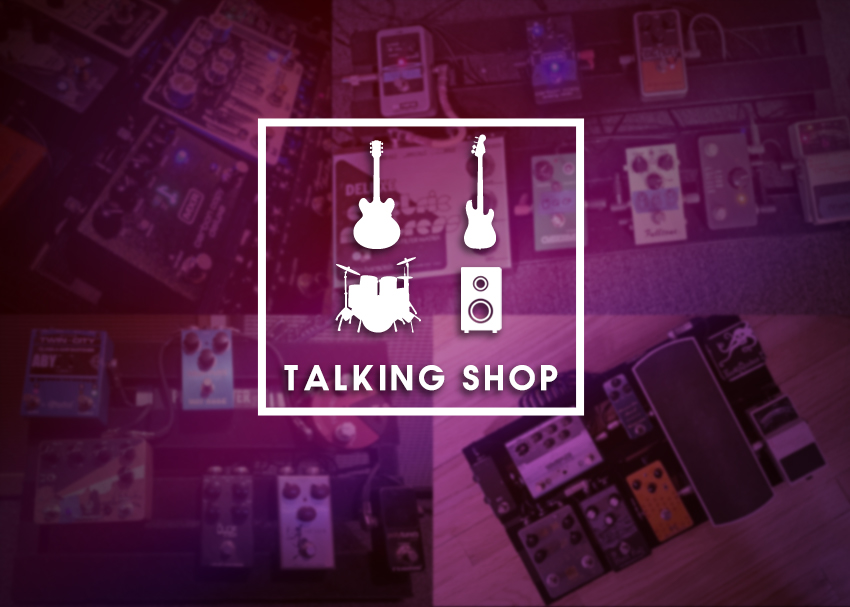


Leave a Reply